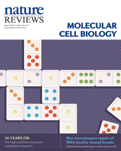|
| TABLE OF CONTENTS | |||||||||||||||||||||||||||||||||||||||
| August 2017 Volume 18 Number 8 | |||||||||||||||||||||||||||||||||||||||
| In this issue
| ||||||||||||||||||||||||||||||||||||||
| |||||||||||||||||||||||||||||||||||||||
 | |||||||||||||||||||||||||||||||||||||||
| Advertisement | |||||||||||||||||||||||||||||||||||||||
| |||||||||||||||||||||||||||||||||||||||
| |||||||||||||||||||||||||||||||||||||||
| PROGRESS | Top | ||||||||||||||||||||||||||||||||||||||
| Physiological functions of programmed DNA breaks in signal-induced transcription Janusz Puc, Aneel K. Aggarwal & Michael G. Rosenfeld p471 | doi:10.1038/nrm.2017.43 Recent evidence indicates that controlled generation of DNA breaks, accompanied by activation of DNA damage repair pathways, can regulate transcription through promoter and enhancer activation and the relief of DNA torsional stress. Abstract | Full Text | PDF | |||||||||||||||||||||||||||||||||||||||
| Advertisement | |||||||||||||||||||||||||||||||||||||||
| REVIEWS | Top | ||||||||||||||||||||||||||||||||||||||
| Vascular heterogeneity and specialization in development and disease Michael Potente & Taija Mäkinen p477 | doi:10.1038/nrm.2017.36 Blood and lymphatic vessels have essential roles in physiology and disease. The endothelial cells that line these vessels specialize to fulfil the needs of the tissue that they pervade. Recent studies in animal models have provided insights into the mechanisms underlying vessel type- and organ-specific specialization, which is crucial for the understanding of several diseases. Abstract | Full Text | PDF | |||||||||||||||||||||||||||||||||||||||
Non-homologous DNA end joining and alternative pathways to double-strand break repair Howard H. Y. Chang, Nicholas R. Pannunzio, Noritaka Adachi & Michael R. Lieber p495 | doi:10.1038/nrm.2017.48 In mammalian cells, DNA double-strand breaks (DSBs) are repaired predominantly by the non-homologous end joining (NHEJ) pathway, which includes subpathways that can repair different DNA-end configurations. Furthermore, the repair of some DNA-end configurations can be shunted to the auxiliary pathways of alternative end joining (a-EJ) or single-strand annealing (SSA). Abstract | Full Text | PDF | Supplementary information | |||||||||||||||||||||||||||||||||||||||
| Mechanisms of DNA replication termination James M. Dewar & Johannes C. Walter p507 | doi:10.1038/nrm.2017.42 The termination of DNA replication involves convergence of replication forks, the completion of DNA synthesis, replisome disassembly and the decatenation of daughter DNA molecules. Recent discoveries illustrate how replisome disassembly in eukaryotes is controlled by E3 ubiquitin ligases and how this activity is regulated to avoid genome instability. Abstract | Full Text | PDF | |||||||||||||||||||||||||||||||||||||||
| Advertisement | |||||||||||||||||||||||||||||||||||||||
| PERSPECTIVES | Top | ||||||||||||||||||||||||||||||||||||||
| TIMELINE The winding path of protein methylation research: milestones and new frontiers Jernej Murn & Yang Shi p517 | doi:10.1038/nrm.2017.35 Protein methylation was discovered over 50 years ago, but only with the advent of genomic and proteomic technologies could its mechanisms and cellular functions be studied in detail. Shi and Murn discuss the seminal discoveries in protein methylation research and highlight future directions for this field. Abstract | Full Text | PDF | |||||||||||||||||||||||||||||||||||||||
| Corrigendum: Transcriptional and epigenetic control of brown and beige adipose cell fate and function Takeshi Inagaki, Juro Sakai & Shingo Kajimura p527 | doi:10.1038/nrm.2017.72 Full Text | PDF | |||||||||||||||||||||||||||||||||||||||
| Advertisement | |||||||||||||||||||||||||||||||||||||||
| |||||||||||||||||||||||||||||||||||||||
| |||||||||||||||||||||||||||||||||||||||
You have been sent this Table of Contents Alert because you have opted in to receive it. You can change or discontinue your e-mail alerts at any time, by modifying your preferences on your nature.com account at: www.nature.com/myaccount For further technical assistance, please contact our registration department For print subscription enquiries, please contact our subscription department For other enquiries, please contact our feedback department Springer Nature | One New York Plaza, Suite 4500 | New York | NY 10004-1562 | USA Springer Nature's worldwide offices: Macmillan Publishers Limited is a company incorporated in England and Wales under company number 785998 and whose registered office is located at The Campus, 4 Crinan Street, London, N1 9XW. © 2017 Macmillan Publishers Limited, part of Springer Nature. All Rights Reserved. |
 |









No comments:
Post a Comment